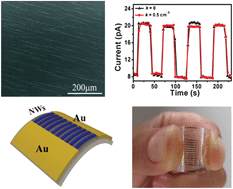Aligned ultralong nanowire arrays and their application in flexible photodetector devices†
Abstract
We develop a facile approach for the one-step growth of ultralong aligned

Maintenance work is planned for Wednesday 1st May 2024 from 9:00am to 11:00am (BST).
During this time, the performance of our website may be affected - searches may run slowly and some pages may be temporarily unavailable. If this happens, please try refreshing your web browser or try waiting two to three minutes before trying again.
We apologise for any inconvenience this might cause and thank you for your patience.
* Corresponding authors
a
Institute of Functional Nano & Soft Materials (FUNSOM) and Jiangsu Key Laboratory for Carbon-Based Functional Materials & Devices, Soochow University, Suzhou, Jiangsu 215123, P. R. China
E-mail:
xjzhang@suda.edu.cn, jason.jsjie@gmail.com
Fax: +86-512-65882846
Tel: +86-512-65880955
b School of mechanical and automobile engineering, Hefei University of Technology, Hefei, Anhui 230009, P. R. China
c
Nano-organic Photoelectronic Laboratory and Laboratory of Organic Optoelectronic Functional Materials and Molecular Engineering Technical Institute of Physics and Chemistry, Chinese Academy of Science, Beijing 100101, P. R. China
E-mail:
xhzhang@mail.ipc.ac.cn
We develop a facile approach for the one-step growth of ultralong aligned

 Please wait while we load your content...
Something went wrong. Try again?
Please wait while we load your content...
Something went wrong. Try again?
Y. Zhang, X. Wang, Y. Wu, J. Jie, X. Zhang, Y. Xing, H. Wu, B. Zou, X. Zhang and X. Zhang, J. Mater. Chem., 2012, 22, 14357 DOI: 10.1039/C2JM31657A
To request permission to reproduce material from this article, please go to the Copyright Clearance Center request page.
If you are an author contributing to an RSC publication, you do not need to request permission provided correct acknowledgement is given.
If you are the author of this article, you do not need to request permission to reproduce figures and diagrams provided correct acknowledgement is given. If you want to reproduce the whole article in a third-party publication (excluding your thesis/dissertation for which permission is not required) please go to the Copyright Clearance Center request page.
Read more about how to correctly acknowledge RSC content.
 Fetching data from CrossRef.
Fetching data from CrossRef.
This may take some time to load.
Loading related content
